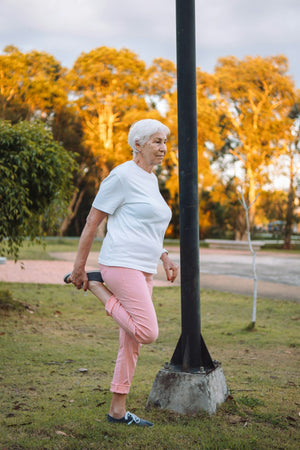Introduction to Joint Health and Aging
As we age, our bodies undergo natural changes, and our joints are no exception.
Joint stiffness, discomfort, and reduced mobility are common complaints among older adults, but joint pain is not an inevitable part of aging.
With proper care, proactive measures, and informed choices, you can maintain joint health and mobility well into your later years.
Why Joint Health Declines with Age
-
Cartilage Wear and Tear: Over time, the cartilage that cushions our joints starts to break down, causing bones to rub together.
-
Reduced Synovial Fluid: The fluid that lubricates joints decreases, leading to stiffness.
-
Weaker Muscles: Loss of muscle mass and bone mass reduces joint stability.
-
Chronic Conditions: Arthritis, osteoporosis, and other conditions become more common with age.
Common Joint Problems in Aging Adults
-
Osteoarthritis (OA): The most common joint disorder caused by cartilage breakdown, OA is a chronic disease among older adults. It often leads to symptoms such as joint pain and stiffness, requiring proper management and medical advice for diagnosis and treatment.
-
Rheumatoid Arthritis (RA): An autoimmune condition causing joint inflammation.
-
Gout: Uric acid buildup causes severe joint pain, usually in the big toe.
-
Bursitis: Inflammation of fluid-filled sacs (bursae) near the joints.
Understanding these challenges is the first step in preventing and managing joint issues effectively.
Lifestyle Changes for Joint Health
Your daily habits play a crucial role in maintaining joint health. Small, consistent lifestyle changes can significantly improve mobility and reduce discomfort.
1. Maintain a Healthy Weight
-
Excess weight places stress on weight-bearing joints like hips, knees, and lower back.
-
Losing even a small percentage of body weight can relieve joint pressure and reduce pain.
-
Follow a balanced diet rich in fruits, vegetables, lean proteins, and whole grains to support weight loss.
2. Eat a Joint-Friendly Diet
Certain nutrients are essential for maintaining joint health and reducing inflammation:
-
Calcium: Found in dairy products, leafy greens, and fortified cereals.
-
Vitamin D: Essential for calcium absorption; found in sunlight, fatty fish, and fortified foods.
-
Omega-3 Fatty Acids: Found in salmon, flaxseeds, and walnuts; reduces inflammation.
-
Antioxidants: Found in berries, spinach, and nuts; combat oxidative stress.
-
Hydration: Maintaining proper hydration is crucial for the health of connective tissue, particularly cartilage, which cushions joints. Inadequate hydration can lead to the body extracting water from connective tissue, negatively affecting joint health.
3. Stay Hydrated
-
Water keeps the cartilage in your joints hydrated and functioning properly.
-
Aim for at least 8 glasses of water daily to prevent joint dryness and stiffness.
-
Avoid excessive caffeine and alcohol, as they can dehydrate the body.
Staying Active and Mobile
Physical activity is one of the most effective ways to prevent and manage joint pain. However, it’s essential to choose exercises that are gentle on your joints.
1. Low-Impact Exercises
Low-impact activities enhance joint mobility while reducing strain on joints:
-
Walking: A simple, weight-bearing exercise that keeps joints flexible.
-
Swimming: Water supports your body weight, reducing joint pressure and promoting joint health.
-
Cycling: Strengthens leg muscles without straining the knees, improving joint mobility.
2. Strength Training
Building muscle strength supports your joints and reduces their workload:
-
Focus on core, thigh, and glute muscles for better joint stability.
-
Use resistance bands or light weights under the guidance of a trainer.
-
Perform exercises like squats, leg presses, and wall sits.
3. Flexibility Exercises
Stretching helps maintain joint range of motion and prevents stiffness:
-
Perform daily hamstring stretches, shoulder rolls, and neck stretches.
-
Incorporate flexibility-focused exercises like yoga and tai chi.
4. Stay Active Throughout the Day
-
Avoid sitting for prolonged periods.
-
Take breaks every 30–60 minutes to stand, stretch, and move around.
-
Practice good posture while sitting and standing.
Preventing Joint Injury and Strain
Injuries can accelerate joint damage, so prevention is crucial.
1. Wear Supportive Footwear
-
Choose shoes with good arch support and cushioning.
-
Avoid high heels and unsupportive sandals to reduce the risk of developing osteoarthritis.
2. Practice Proper Body Mechanics
-
Lift heavy objects using your legs, not your back.
-
Avoid twisting motions when lifting or bending.
-
Use assistive devices like canes or braces if needed.
3. Avoid Overexertion
-
Know your limits and stop if you experience pain.
-
Alternate between high-impact and low-impact activities.
-
Build exercise intensity gradually over time.
4. Protect Joints During Activities
-
Use protective gear during sports or physical activities.
-
Warm up and cool down during workouts.
Managing Joint Pain
Persistent joint pain should not be ignored. Early intervention can prevent long-term damage.
1. Non-Surgical Treatments
-
Over-the-Counter Medications: NSAIDs (e.g., ibuprofen) reduce pain and inflammation.
-
Joint Injections: Corticosteroid injections can offer temporary relief.
-
Physical Therapy: Customized exercises can improve joint function.
2. Surgical Interventions
For severe cases, surgery may be recommended to improve mobility and reduce pain:
-
Knee Replacement Surgery: For advanced osteoarthritis.
-
Hip Replacement Surgery: For severe joint damage.
-
Joint Replacement Surgery: Total hip and knee replacements are common procedures that can significantly enhance quality of life for seniors with severe joint issues.
-
Joint Fusion Surgery: For stabilizing smaller joints.
3. Rehabilitation After Surgery
-
Follow a structured physical therapy plan post-surgery.
-
Focus on gentle stretches and strengthening exercises.
-
Stay committed to your recovery routine.
Monitoring and Maintaining Joint Health
1. Regular Health Check-Ups
-
Regular screenings help detect joint problems early. Internal medicine physicians play a crucial role in diagnosing and managing age-related diseases such as arthritis, ensuring comprehensive care.
-
Discuss persistent pain, swelling, or stiffness with your doctor. Your primary care physician can conduct examinations and refer you to specialists when necessary, illustrating the integrative approach of internal medicine in treating chronic conditions.
2. Maintain Healthy Sleep Patterns
-
Quality sleep helps repair tissues and reduce inflammation.
-
Follow a consistent sleep schedule and create a relaxing bedtime routine.
3. Stay Hydrated
-
Proper hydration prevents cartilage breakdown and supports mobility.
4. Track Your Joint Health
-
Keep a pain journal to track symptoms and triggers.
-
Share this information with your healthcare provider during appointments.
Staying Motivated and Engaged
1. Set Realistic Goals
-
Start small and celebrate milestones.
-
Track progress with fitness apps or a journal.
2. Find a Workout Buddy
-
Exercising with a friend can boost motivation and accountability.
-
Join fitness classes designed for older adults.
3. Diversify Your Routine
-
Mix aerobic, strength, and flexibility exercises to help maintain healthy joints.
-
Try fun activities like dancing or water aerobics.
Frequently Asked Questions
1. How can you keep your joints healthy as you age?
Maintain an active lifestyle, eat a balanced diet, stay hydrated, and avoid injuries.
2. What is the best treatment for aging joints?
A combination of low-impact exercise, anti-inflammatory supplements, medications, and physical therapy works best.
3. How do you stop joint pain in old age?
Incorporate regular exercise, weight management, and an anti-inflammatory diet into your routine.
4. How do I stop stiffness as I age?
Practice daily stretching, stay active, and maintain proper hydration.
Essential Tips for Maintaining Aging Joint Health and Mobility Conclusion
Maintaining joint health as you age requires proactive care, consistency, and a well-rounded approach.
By adopting a balanced diet, staying physically active, preventing injuries, and seeking medical care when needed, you can protect your joints and maintain mobility for years to come.
Remember, joint pain isn't an inevitable part of aging. With the right habits and care, you can continue to lead an active, pain-free life well into your golden years.
Always consult a healthcare provider before starting new exercise routines or supplements to ensure they're safe and effective for your unique needs.


